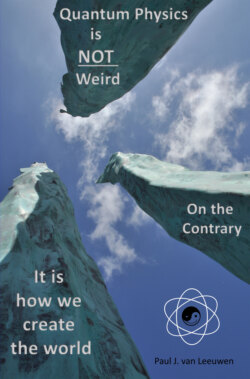Читать книгу Quantum Physics is not Weird. On the Contrary. - Paul J. van Leeuwen - Страница 35
На сайте Литреса книга снята с продажи.
Serendipity with electrons
ОглавлениеSerendipity often plays a role in important discoveries in physics. Think of Wilhelm Röntgen's discovery of X-rays because a screen with barium platinocyanide, that he happened to have standing somewhere in his lab, lit up. How wave behavior of electrons was confirmed experimentally is another excellent example of serendipity. From 1921 on Clinton Davisson did research into the atomic structure of metals. Apparently inspired by Rutherford's experiment with alpha particles and gold atoms, he bombarded metal with narrow beams of electrons and tried to glean some insights into the structure of the metal by measuring accurately the reflected intensity at different reflection angles.
Davisson used a specially constructed device [24] that could produce a narrow electron beam aimed at a block of nickel fixed on a 360o rotatable holder. The reflected electrons were collected with an electron catcher device with which the collected charge could be measured. This device could slide along a quarter of an arc, so the varying intensity of the reflected electrons could be measured over different angles from 0o to 90o. See figure 4.13. The rotation of the nickel holder over 360o combined with the 90o slide of the electron catcher meant that electron reflection from the nickel surface could be measured over an almost complete hemisphere. The entire device was contained in a glass casing which could be made vacuum.
Figure 4.13: Davisson-Germer experiment.
Source: Wikimedia Commons.
Their first experiments with this device yielded not much useful information. Due to an accident during those experiments, air did enter the device. Davisson discovered that the surface of the nickel target had become oxidized as a result of the accident. In order to repair this, his assistant heated the nickel block and polished it thereafter in order to obtain again a perfectly unblemished smooth target surface. However, the unintended effect of this heating was that the the surface of the nickel target had become crystallized.
Now their device suddenly produced interesting results. The measurements with the repaired device suddenly yielded measurements that indicated that the electrons were only reflected in certain directions. They measured maxima and minima, just like an interference pattern, but Davisson did not understand how that could be. Because he considered electrons as small hard balls, he did not expect interference effects. Davisson could not understand his strange interference-like results. Despite not being able to understand what his measurements implied, he published a report, describing his set-up and the measurement results, in Science, his professional publication medium.
During a short holiday in 1926 with his family in England, Davisson attended a lecture by Max Born (1882-1970) in Oxford about recent developments in quantum physics. Born presented, to Davisson's utter surprise, the results published in Science of Davisson's experiment. Born's interpretation was that De Broglie's hypothesis of electron waves was convincingly confirmed by Davisson's results because they showed interference effects brought about by a diffraction grid of crystallized nickel atoms.
Understandably, Davisson could hardly wait to return to his laboratorium in the US. He probably already suspected a Nobel Prize waiting for him. He improved his device together with Germer so that the angles of reflection could be measured more accurately, resumed his experiments and got now excellent results which he then published in Nature in 1927.
By varying the voltage in the electron gun, he was able to vary the energy and therefore the velocity of the electrons very precisely and thus also their wavelength according to the De Broglie relation λ = h/(mv). By his interference results he could now determine the relationship between the wavelength of his electrons and the distance between the nickel atoms in the crystallized nickel lattice. The nickel atoms in the crystal lattice apparently acted as a three-dimensional diffraction grid. Re-read for better understanding of this effect the previous paragraph on diffraction grids if necessary.
In 1937, Davisson shared the Nobel Prize in physics [25] with the British scientist George Paget Thomson who demonstrated electron diffraction by shooting them through diffraction grids formed by very thin metal films.
The experimental confirmation of the wave behavior of electrons gave the Bohr atomic model a firmer foothold, but the idea that particles also had a wave character caused serious headaches to many colleagues and other contemporaries.
Classical Newtonian physics was still firmly anchored in the minds of most physicists of that time, something that seems today still to be the case for the minds of scientists working in fields other than quantum physics. People still expect to see an objective world that behaves predictably and does not show itself from two contradictory aspects at the same time. Physics students were discouraged to philosophize about the strange paradoxes in quantum physics, as long as the results of their experiments matched their calculations. Which meant: "Shut up and calculate.". An admonition uttered by David Mermin, not by Richard Feymann, to set records straight here. After all, quantum mechanics calculations worked extremely well and accurately, considering the successes which were achieved. So, why worry?
